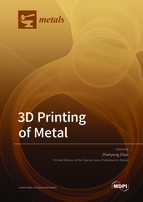3D Printing of Metal
A special issue of Metals (ISSN 2075-4701). This special issue belongs to the section "Additive Manufacturing".
Deadline for manuscript submissions: closed (31 December 2022) | Viewed by 25453
Special Issue Editor
Interests: metal 3D printing; laser cladding; semi-solid forming
Special Issues, Collections and Topics in MDPI journals
Special Issue Information
Dear Colleagues,
Metal 3D printing, as an advanced forming, can manufacture parts directly from digital model by using layer by layer material build-up approach. This manufacturing method can prepare complex shape metal parts in short time, with and high precision. 3D printing processes can be classified into two major groups, Powder Bed Fusion based technologies and Directed Energy Deposition. 3D printing features freedom to part complexity, part design and light-weighting for aerospace, automobile and other industries application. The Global Metal 3D Printing Market is mainly driven by the the fast developing of aerospace and automobile industry. The Global Metal 3D Printing Market size was valued at USD 534.18 Million in 2020 and is projected to reach USD 4458.76 Million by 2028, growing at a CAGR of 30.38% from 2021 to 2028.
In this Special Issue, we welcome articles that focus on metal 3D printing materials, processes and their influence on the final products’ microstructure and performance, providing guidance for the development of metal 3D printing technology.
Prof. Dr. Zhanyong Zhao
Guest Editor
Manuscript Submission Information
Manuscripts should be submitted online at www.mdpi.com by registering and logging in to this website. Once you are registered, click here to go to the submission form. Manuscripts can be submitted until the deadline. All submissions that pass pre-check are peer-reviewed. Accepted papers will be published continuously in the journal (as soon as accepted) and will be listed together on the special issue website. Research articles, review articles as well as short communications are invited. For planned papers, a title and short abstract (about 100 words) can be sent to the Editorial Office for announcement on this website.
Submitted manuscripts should not have been published previously, nor be under consideration for publication elsewhere (except conference proceedings papers). All manuscripts are thoroughly refereed through a single-blind peer-review process. A guide for authors and other relevant information for submission of manuscripts is available on the Instructions for Authors page. Metals is an international peer-reviewed open access monthly journal published by MDPI.
Please visit the Instructions for Authors page before submitting a manuscript. The Article Processing Charge (APC) for publication in this open access journal is 2600 CHF (Swiss Francs). Submitted papers should be well formatted and use good English. Authors may use MDPI's English editing service prior to publication or during author revisions.
Keywords
- metal 3D printing
- laser cladding
- semi-solid forming
- microstructure
- mechanical properties
- performance






